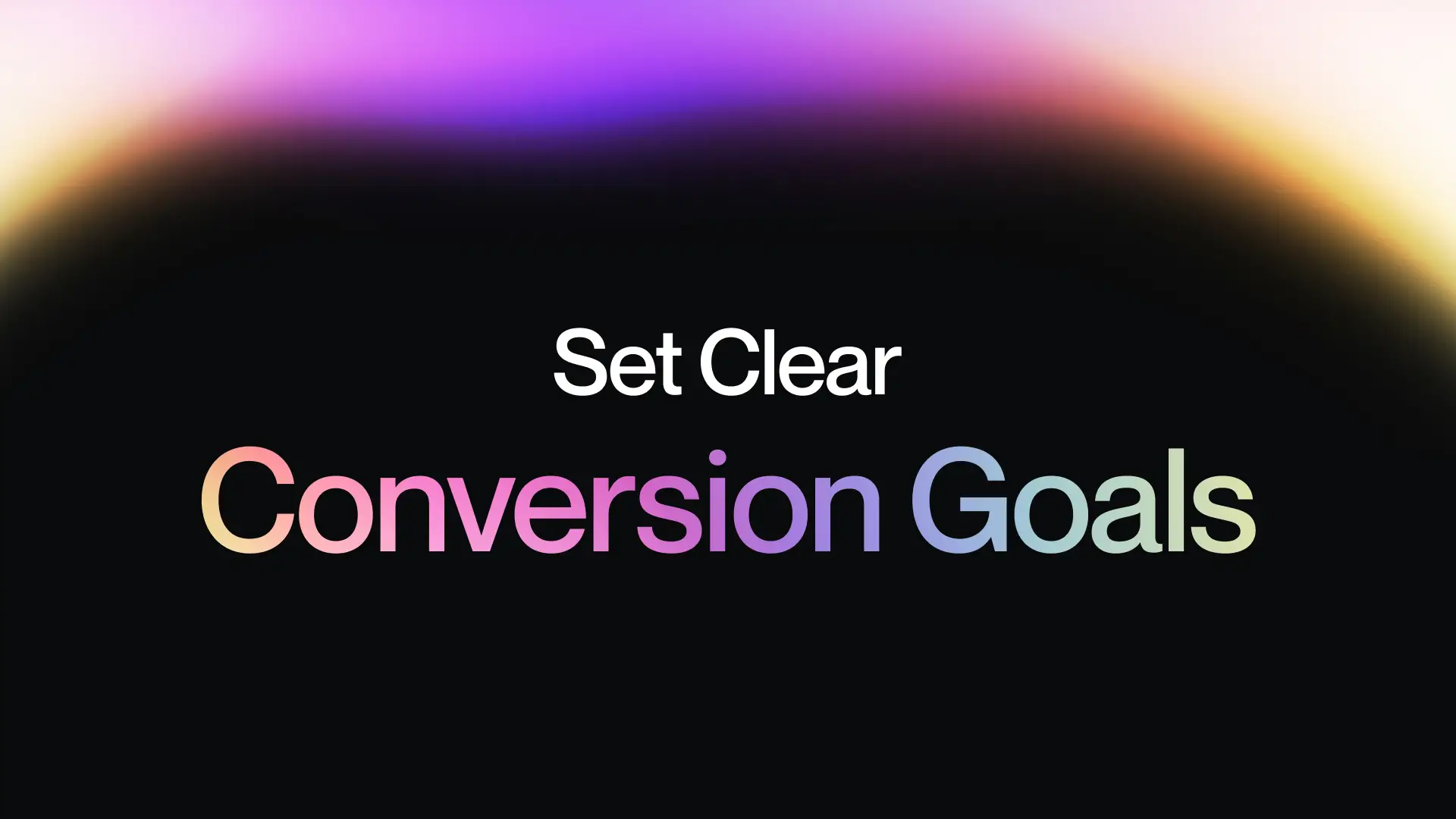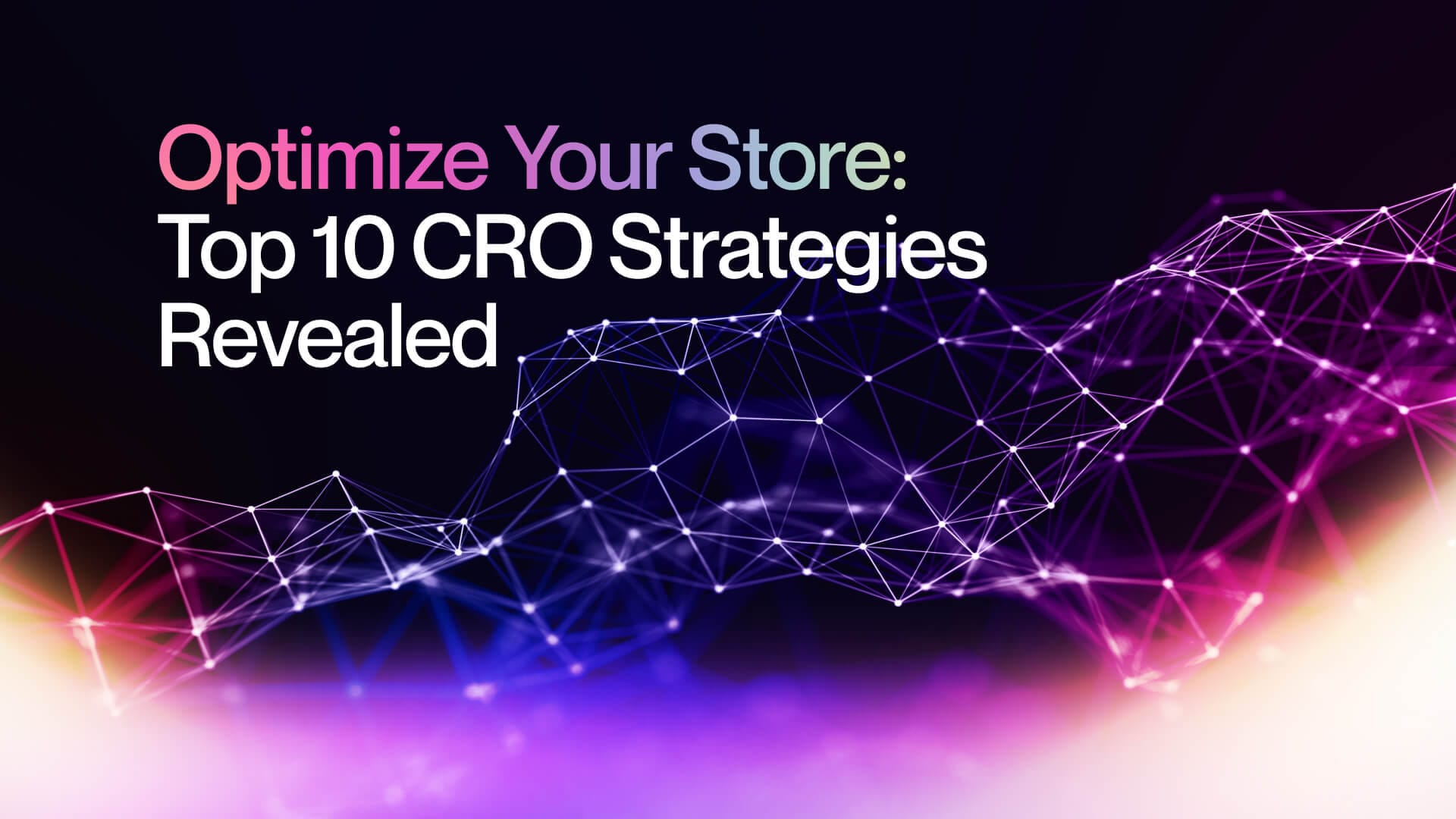Conversion Rate Optimization (CRO) is an essential and detailed process, crucial for identifying and implementing the most effective techniques to boost your online presence and performance.
In this article, you will learn about tips and tricks that will help you achieve CRO success.
1. Set Clear Conversion Goals

To enhance the effectiveness of your optimization strategies, start by establishing precise and measurable conversion goals.
These goals should clearly define what constitutes a successful outcome for your campaign, such as increasing newsletter sign-ups by 20%, boosting online sales by 15%, or achieving a 30% rise in form submissions on your website.
These objectives will not only guide your optimization efforts but also provide clear benchmarks to evaluate their success.
By having specific targets, you can tailor your strategies to directly address these goals, ensuring a more focused and results-driven approach to optimization.
2. Optimize Popup Timing
To effectively leverage popups in your digital strategy, it's crucial to implement them with careful consideration of timing and user engagement.
Begin by analyzing user behavior patterns on your website, such as the average time spent on specific pages or the actions are taken before leaving.
Based on this data, strategically time your popups to appear at moments of maximum engagement, like just as a user is about to leave a page or after they've spent a significant amount of time on a particular section.
Tailor the content of your popups to align with the user's current interaction. For example, if a user is reading a detailed article, a popup offering a related whitepaper or newsletter subscription can be relevant and valuable.
On e-commerce sites, showing a popup with a discount or special offer after a user has viewed several products can encourage conversion.
3. Craft Persuasive Calls-to-Action (CTAs)
.webp)
The design of the CTA should also be attention-grabbing, with contrasting colors and fonts that make it stand out from the rest of the page, yet still align with your overall website design.
Placement is key, positioning CTAs in obvious areas where users are most likely to engage, such as near compelling content or at the end of informative blog posts.
Personalize the CTA based on the user's journey and interaction with your site. For example, a first-time visitor might see a CTA inviting them to subscribe to a newsletter, while a returning visitor might be prompted to take advantage of a loyalty discount.
In addition to the text and design, test different versions of your CTAs to see which resonates best with your audience.
Utilize A/B testing to compare different phrases, colors, and placements, and use the data collected to refine your approach continuously.
Do you want to optimize your conversion rates? Reach out to Imbassy and maximize your online performance with our results-driven CRO services.
4. Eliminate Conversion Barriers
It is critical to identify and eliminate barriers that could be impeding your sales.
This involves a thorough examination of your customer journey to pinpoint any obstacles that might discourage potential customers from completing a purchase.
Start by evaluating your account creation process. If it is overly complex or time-consuming, it could deter users from proceeding.
Simplify this process by reducing the number of required fields, allowing social media account integration for quick sign-ups, or even providing a guest checkout option for those who prefer not to create an account.
Another key area to review is your payment options. Limited payment methods can be a significant conversion barrier.
Expand your payment gateway to include a variety of options such as credit and debit cards, PayPal, digital wallets like Apple Pay or Google Wallet, and even cryptocurrency if applicable.
This not only caters to a wider range of preferences but also instills a sense of security and convenience for the user.
Analyze other potential hindrances like slow website loading times, complicated navigation, or unclear pricing structures.
Optimizing your website for speed, ensuring easy navigation, and providing transparent pricing information can greatly enhance the user experience and reduce bounce rates.
It's also beneficial to gather feedback directly from your customers through surveys or feedback forms.
This can provide valuable insights into user experience issues that you may not have identified.
5. Implement A/B Testing

You must look at A/B testing as a methodical approach for comparing different elements of your website.
This process involves creating two versions of a webpage or a specific element on your website, such as a Call-to-Action (CTA) button, headline, or landing page layout.
Each version (A and B) is shown to a different segment of your website visitors to determine which one performs better in terms of key metrics like click-through rates, conversion rates,
or time spent on the page.
Begin by identifying the elements you want to test.
These could range from the color and text of your CTA buttons, the placement of testimonials, and the layout of your product pages, to the images used in your headers.
Make sure that you change only one variable at a time for each test to accurately measure its impact.
Once you have your variations, use an A/B testing tool to randomly serve these different versions to your visitors.
It's important to ensure a significant sample size and testing duration to collect reliable data.
Monitor the performance of each variation in terms of user engagement, conversions, and other relevant metrics.
After the testing period, analyze the data to see which version had the better performance.
The results will offer valuable insights into user preferences and behavior on your site.
Use these findings to refine your website elements, enhancing the overall user experience and effectiveness of your site in achieving its goals.
6. Harness Social Proof
To effectively build trust and credibility with potential customers, it's essential to leverage testimonials, reviews, and Success Missions strategically.
These elements serve as social proof, demonstrating to prospective buyers that your products or services are both valued and effective, thereby increasing the likelihood of conversions.
Start with testimonials gather authentic feedback from satisfied customers and showcase these endorsements prominently on your website.
For greater impact, include the full name, designation, and a photograph of the person, if they consent.
This personal touch adds authenticity.
Diversify the types of testimonials to include both short, impactful quotes and longer, more detailed stories of customer satisfaction.
Place these strategically across your site, especially on landing pages, product pages, and at checkout points.
Reviews are equally important. Encourage customers to leave reviews on your website and other platforms relevant to your industry, like Google, Yelp, or Amazon.
Implement a simple and accessible system for submitting reviews, and consider incentivizing the process.
Regularly monitor and respond to these reviews, addressing any negative feedback constructively and appreciatively.
Showcasing a balance of positive and critical reviews demonstrates transparency and a commitment to continuous improvement.
Success Missions are particularly powerful in converting prospects, especially in B2B scenarios.
Create in-depth Success Missions that detail how your product or service solved a specific problem or enhanced business outcomes for a client.
Include quantitative data, before-and-after comparisons, and direct quotes from the client.
Make these Success Missions easily accessible on your website, and consider creating different formats, like written documents, videos, or infographics, to cater to different audience preferences.
6. Minimize Bounce Rates with Targeted Content

To effectively engage your audience and minimize the chances of them leaving your website prematurely, it's crucial to deliver content that precisely aligns with their interests and needs.
This approach involves a deep understanding of your audience, including their preferences, pain points, and the kind of information they are seeking.
Begin by conducting thorough audience research. Utilize tools like surveys, feedback forms, and social media interactions to gather insights into what your audience values.
Analyze the data to identify common questions, challenges, and topics of interest. Leverage analytics tools to understand the types of content that have historically performed well with your audience.
Once you have a clear understanding of your audience's interests, tailor your content accordingly.
This might involve creating detailed blog posts, informative articles, engaging videos, or interactive infographics that address their specific needs and questions.
For instance, if your audience is primarily interested in health and fitness, providing well-researched articles on workout routines, nutrition tips, or wellness trends would be beneficial.
It's also important to ensure the relevance of the content.
Keep your content updated with the latest information, trends, and insights relevant to your audience's interests.
This not only maintains their engagement but also positions your site as a reliable and up-to-date source of information.
7. Retarget with Customized Offers
To effectively re-engage visitors who have left your site, implementing sophisticated retargeting techniques is a strategic approach.
This involves using online advertising to remind these previous visitors of your products or services, and enticing them with personalized promotions that resonate with their interests.
Start by setting up retargeting campaigns using platforms like Google Ads or Facebook Pixel.
These tools track users who have visited your site and then display your targeted ads to them as they browse other websites or social media platforms.
This keeps your brand top-of-mind and increases the likelihood of them returning.
Personalization is key in making these retargeting efforts more effective.
Analyze the browsing behavior and past interactions of these visitors on your site to understand their interests and preferences.
Use this data to create personalized ads that are specifically tailored to their individual needs.
For example, if a visitor looked at a particular product but didn’t make a purchase, you can retarget them with ads for that specific product, perhaps offering a limited-time discount or an exclusive bundle.
In addition to product-specific targeting, consider segmenting your audience based on their behavior.
Create different retargeting strategies for visitors who abandoned their shopping cart, those who browsed specific categories, and those who only visited your homepage.
Tailoring your messages and offers to these different segments can significantly increase the relevance and effectiveness of your campaigns.
8. Deploy Exit-Intent Popups

Implementing exit-intent popups is a strategic method to re-engage users just as they are about to leave your website.
These popups are designed to activate when the user's cursor moves to close the tab or browser, signaling their intent to exit.
The goal is to capture their attention at this pivotal moment with a compelling message or offer that encourages them to reconsider and complete their purchase.
To effectively utilize exit-intent popups, it's crucial to integrate sophisticated exit-intent technology on your website.
This technology should be capable of accurately detecting the precise moment when a user is about to leave.
Once this intent is identified, the popup should appear seamlessly, drawing the user's attention without feeling intrusive or disruptive.
The content of the popup is key to its success. It should offer a clear and enticing incentive that aligns with the user's interests and the context of their visit.
For example, if a user was browsing a product but didn't add it to their cart, the popup might offer a limited-time discount or free shipping for that specific product.
If the user has items in their cart, the incentive might be a discount code or a freebie if they complete the purchase immediately.
Personalization enhances the effectiveness of these popups. Use data on the user's browsing history and cart contents to tailor the popup's message.
A personalized approach shows users that you understand their needs and preferences, making the offer more relevant and appealing.
9. Utilize Analytics Tools like Heatmaps
To enhance your website's effectiveness and user experience, applying analytical tools like heatmaps is a crucial strategy.
Heatmaps provide a visual representation of user behavior on your website, such as where they click, how far they scroll, and which areas they focus on.
By analyzing this data, you can gain valuable insights into how users interact with your site and use this information to make informed improvements.
Start by selecting a robust heatmap tool that aligns with your website’s needs.
There are several types of heatmaps, including click maps that show where users are clicking, scroll maps that reveal how far down they scroll, and attention maps that indicate where users spend the most time.
Implementing these tools on your key pages, like the homepage, product pages, and landing pages, will give you a comprehensive understanding of user interactions.
Once you have collected enough data, analyze the heatmaps to identify patterns. Look for areas with high engagement to understand what captures users' attention.
Similarly, note the sections that are being ignored or where users drop off, as these might indicate areas of your website that need improvement.
Use this data to optimize the layout and content of your website. For instance, if the heatmap shows that users often click on a particular image or section, consider enhancing that area with additional information or a clearer call to action.
If you notice that users are not scrolling down to important content, you may need to reorganize your page layout to make key information more visible.
Heatmaps can also be invaluable for testing changes to your website.
Before and after implementing a change, compare heatmaps to see how user behavior has shifted.
This direct feedback can guide you in fine-tuning your website design and content to better suit your audience's preferences.
Final Thoughts
These strategies are centered around effectively identifying and achieving conversion objectives, employing a blend of data-driven methodologies and user-focused tactics to enhance the conversion rate of your website.
By leveraging analytical insights and tailoring your approach to align with user preferences and behaviors, these methods aim to refine and elevate the effectiveness of your website, ultimately driving higher conversion rates.
Author


.jpg)
